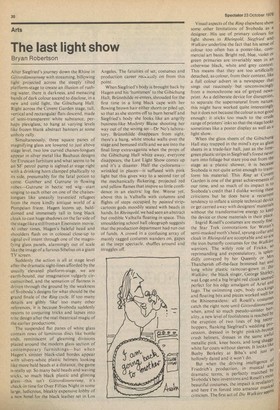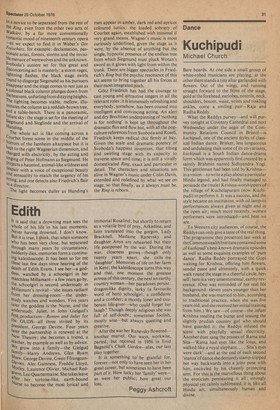Arts
The last light show
Bryan Robertson
Alter Siegfried's journey down the Rhine in Gorterclammerung with streaming, billowing light projected across the steeply tilted platform-stage to create an illusion of rushing water, there is darkness, and menacing bands of dark colour ascend to disclose, in a new and cold light, the Gibichung Hall. Right across the Covent Garden stage, tall.
vertical and rectangular flats descend, made of semi-transparent white substance, perhaps plexiglass, to hang at varying levels like frozen blank abstract banners at some unholy rally.
Simultaneously, three square panes of magnifying glass are lowered to just above stage level, two low curved chaises-longues appear in silver metal like Bauhaus designs for Etruscan furniture and what seems to be an SF petrol pump is sighted at stage right with a drinking horn clamped phallically to its side, presumably for the fatal potion to come. Gunther and Gutrune in flowing robes—Gutrune in hectic red wig---start singing to each other on one of the chaiseslongues like uneasily travestied refugees from the more kindly antique world of a Pompeian frieze. Hagen looms up. balddomed and immensely tall in long black cloak to cast huge shadows on the far side of thestagelikea still froman Eisenstein movie. At other times, Hagen's baleful head and shoulders flash on in colossal close-up to signal evil intent through one of the magnifying glass panels, alarmingly out of scale like the image of a furious Sibelius on a giant TV screen.
Suddenly the action is all at stage level after the dramatic sight-lines afforded by the usually elevated platform-stage, we are earth-bound, our imagination vulgarly circumscribed, and the sensation of flatness is driven through the ground by the weakness of S‘oboda's designs for what should be the grand finale of the Ring cycle. If too many details are glibly 'like' too many other references, it is because Svoboda suddenly resorts to conjuring tricks and lapses into trite design after the real theatrical magic of the earlier productions.
The suspended flat panes of white glass contain rows of luminous discs like bottle ends, reminiscent of gleaming divisions placed around the modern glass section of contemporary furnishings-but when Hagen's sinister black-clad hordes appear with silvery-white plastic helmets looking like more bald heads at a distance, the game is really up. So many bald heads and waving sticks, so much black plastic and glinting glass-this isn't Gatierdannnerung, it's check-in time for Over Fifties Night in some large, ludicrous, bleakly expensive lobby of a new hotel for the black leather set in Los Angeles. The fatuities of set, costumes and production career rec.iessly on from this point.
When Siegfried's body is brought back by Hagen and his 'huntsmen' to the Gibichung Hall, Briinnhilde re-enters, shrouded for the first time in a long black cape with her flowing brown hair either shorn or piled up, so that as she storms off to burn herself and Siegfried's body she looks, like an angrily business-like Modesty Blaise shooting her way out of the wrong set —Dr No's laboratory. Briinnhilde disappears from sight, there's a bang, white smoke wafts over the stage and bemused stalls and we are into the final limp extravaganza when the props of the Gibichung Hall whizz away, everyone disappears, the Last Light Show comes up and it's a disaster. Half the cyclorama-wrinkled in places—is suffused with pink light but this gives way to a second tier of the mechanically flickering, projected red and yellow flames that inspire so little confidence in an electric log fire. Worse yet, above this is Valhalla with columns and flights of steps occupied by painred stripcartoon gods moodily seated with heads in hands. In Rheingold, we had seen an abstract but credible Valhalla floating in space. This smouldering school hall oleograph suggests that the production department had run out of funds. A crowd in a confusing array of mainly ragged costumes wanders on, gapes at the inept spectacle, shuffles around and straggles off.
Visual aspects of the Ring elsewhere show some other limitations of Svoboda as a designer. His use of primary colours for light shows in Rheingold, Siegfried and Walkiire underline the fact that his sense of
colour too often has a poster-like, commercial art basis. Bright red, blue, violet or green primaries are invariably seen in an otherwise black, white and grey context. This means that they are too artificiallY detached, as colour, from their context, like a full colour advert in a newspaper that sings out raucously but unconvincing/Y from a monochrome sea of greyed newsprint. As a deliberate device for disruption. to separate the supernatural from nature, this might have worked quite interestinglY but it does not because the colour is not good enough: it sticks too much to the crude range of printers' inks so that the stage looks sometimes like a poster display as well as a light show.
When the glass sheets of the Gibichung Hall stay trapped in the mind's eye as glass sheets in a trade-fair hall, just as the lime' green plastic strips in Siegfried's forest never turn into foliage but stare you out from the stage as a plastic shower, it is because Svoboda is not quite artist enough to transform his material. This Ring at Covent Garden is one of the great achievements of our time, and so much of its impact is to Svoboda's credit that I dislike writing these criticisms but he does have a recurrent tendency to inflate a simple technical device or get carried away with designers' materials without the transformative energy to keeP the device or those materials in their place: Ingrid Rosell's costumes are mostly fine: the Star Trek connotations for Wotan s semi-masked moth's head, sprung collar and cloak in Rheingoldare acceptable and so are -the iron butterfly costumes for the Wu/kure warriors. The wifely role of Fricka, s° reprimanding and expostulatory, is splendidly conveyed by her Queenly or Mrs, Thatcherish off-the-face brimmed hat all long white plastic raincoat-gown in Die Walkiire; the black singer. George ShirleY: was Loge and a big bright red cloak seeMea, perfect for his edgy amalgam of Ariel art lago. The swimming caps, body stockings and floating bits and pieces worked well fc'r the Rhinemaidens: all Rosell's costumes catch the right note until GorterdiUnnterung when, amid so much pseudo-sinister ballality, a new level of foolishness is reached hY the eruption of two lines of big tee°Y. boppers, flanking Siegfried's wedding Pr° cession, dressed in brightpinkish-bronzei crash helmets, dresses in the same awf° metallic pink, knee boots, and long shag.gy white fur coats without sleeves. It looks like Busby Berkeley at Biba's and just as
hollowly dated and it won't do. of But when the driving intelligence hollowly dated and it won't do. of But when the driving intelligence
, d
Friedrich's production, in musical an dramatic terms, is perfectly matched hYt
SVoboda's best inventions and Rosel s
l'e
beautiful costumes. the impact is rvia e
mtoorsy
and here I'm forced into amateur musical criticism. The first act of Die Walkiire seems
to a novice to be separated from the rest of the Ring, even from the other two acts of Hialkiire, by a far more conventionally romantic mood of nineteenth century opera —as we expect to find it in Weber's Der Freischiitz, for example: declamation, passionate arias, forests, storms and the invisible menace of werewolves and the unknown. Svoboda's austere set for this great and disconcerting act is masterly : a storm rages, lightning flashes, the black stage swirls round to disgorge Siegmund as his pursuers disappear and the stage comes to rest just as a colossal black column plunges down from the heavens, unfurling from dizzying heights. The lighting becomes stable, mellow, illunimates the column as a reddish-brown tree, and a table-bench. There is a panoramic, foliate sky : the stage is set for the meeting of Siegmund and Sieglinde and the arrival of Hunding. The whole act is like coming across a Cdurbet forest scene in the middle of the horrors of the Isenheim altarpiece but it is kept to the right Wagnerian dimension, and charged with electricity, by the acting and singing of Peter Hofmann as Siegmund. He Projects a haunted, animal-like wildness and desPair with a voice of exceptional beauty `Ind sensuality to match the urgency of his acting, and one detects also Friedrich's flair as a director.
The light becomes duller as Hunding's men appear in amber, dark red and apricot coloured tunics: the loaded sobriety of Courbet again, established with minimal if very grand means. Wagner's music is most curiously underlined, given the stage as it were, by the absence of anything but the single, hypnotic presence of the endless tree from which Siegmund must pluck Wotan's sword as it glows with light from within the trunk. There are bigger spectacles in Friedrich's Ring but the psychic resonance of this act seems to bring together all his forces at their most integrated pitch.
Gotz Friedrich has had the courage to cast young and attractive singers in all the relevant roles: it is immensely refreshing and everybody, somehow, has been coaxed into intelligent and convincing acting. An alert and dry Brecht ian underpinning of 'nothing is for nothing' is kept up throughout the dramatic flux and flow but, with all the popculture references from Svoboda and Rosell, Friedrich keeps radical chic firmly at bay. Given the scale and dramatic potency of Svoboda's happiest invention, that tilting and swirling stage with its capacity to traverse space and time, it is still a vividly domesticated Ring, exact and particular in detail. The characters and situations are alive in Wagner's music under Colin Davis, extended and redefined by what we see on stage, so that finally, as it always must be, the Ring is reborn.











































 Previous page
Previous page